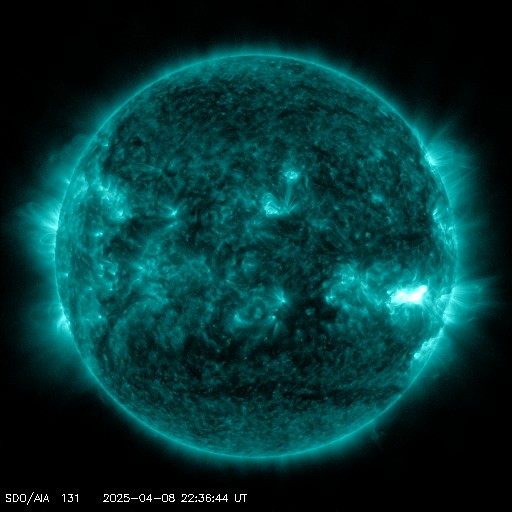Viewing archive of Wednesday, 29 September 2021
Daily bulletin on solar and geomagnetic activity from the SIDC
Issued: 2021 Sep 29 1231 UTC
SIDC Forecast
Solar flares
C-class flares expected, (probability >=50%)
Geomagnetism
Quiet (A<20 and K<4)
Solar protons
Quiet
| 10cm flux | Ap | |
|---|---|---|
| 29 Sep 2021 | 089 | 007 |
| 30 Sep 2021 | 091 | 007 |
| 01 Oct 2021 | 093 | 014 |
Bulletin
Four active regions (ARs) present on the visible solar disk. NOAA AR 2871 has decayed from beta-gamma magnetic field configuration, to alpha. Two new ARs: NOAA AR 2880 (beta) and 2881 (alpha). The former produced a C1.3 flare peaking at 02:18 UT. There’s also a new region rotating into view. Over the next 24 hours, more C-class flares can be expected.
No Earth directed CMEs have been observed in the last 24 hours.
The greater than 10 MeV proton flux was at background levels in the past 24 hours, and is expected to stay there in the next 24 hours. The greater than 2 MeV electron flux remained below the 1000 pfu alert threshold, it may increase over the next 24 hours. The electron fluence was at normal levels over the past 24 hours, it may increase over the next 24 hours.
The Earth is still inside the high speed solar wind from the low latitudinal extension of the northern polar coronal hole (positive polarity). Solar wind speeds have reached 550 km/s with magnetic fields up to 6 nT (with Bz up to -3 nT). Over the next 24 hours we expect a return to slow solar wind.
Geomagnetic conditions were quiet to unsettled for Kp (NOAA Kp 1-3) and reached active periods locally at Dourbes (K Dourbes 2-4) over the past 24 hours, quiet to unsettled conditions can be expected for the next 24 hours. An ICME is expected to arrive after 24 hours and produce active to moderate storm levels.
Today's estimated international sunspot number (ISN): 074, based on 12 stations.Solar indices for 28 Sep 2021
| Wolf number Catania | 075 |
| 10cm solar flux | 089 |
| AK Chambon La Forêt | 017 |
| AK Wingst | 013 |
| Estimated Ap | 012 |
| Estimated international sunspot number | 055 - Based on 23 stations |
Noticeable events summary
| Day | Begin | Max | End | Loc | Strength | OP | 10cm | Catania/NOAA | Radio burst types | |
|---|---|---|---|---|---|---|---|---|---|---|
| None | ||||||||||
Provided by the Solar Influences Data analysis Center© - SIDC - Processed by SpaceWeatherLive
All times in UTC
Current data suggests there is a slight possibility for aurora to appear at the following high latitude regions in the near future
TórshavnOulu, Rovaniemi, Sodankylä
Reykjavik
Tromsø, Trondheim
Arkhangelsk
Kiruna, Luleå, Sundsvall, Umeå
Latest news
Latest forum messages
Support SpaceWeatherLive.com!
A lot of people come to SpaceWeatherLive to follow the Sun's activity or if there is aurora to be seen, but with more traffic comes higher server costs. Consider a donation if you enjoy SpaceWeatherLive so we can keep the website online!

Latest alerts
22:42 UTC - Solar flare
Moderate M1.57 flare
22:24 UTC - Radio Blackout
Minor R1 radio blackout in progress (≥M1 - current: M1.52)
15:15 UTC - Geomagnetic activity
Minor G1 geomagnetic storm (Kp5) Threshold Reached: 14:59 UTC
06:30 UTC - Type II Radio Emission
Begin Time: 08/04/2025 05:53 UTC Estimated Velocity: 456km/sec.
05:15 UTC - Hemispheric Power Index
The OVATION model predicts the Hemispheric Power Index to reach 50GW at 06:02 UTC
Space weather facts
| Last X-flare | 2025/03/28 | X1.1 |
| Last M-flare | 2025/04/05 | M1.0 |
| Last geomagnetic storm | 2025/04/06 | Kp5 (G1) |
| Spotless days | |
|---|---|
| Last spotless day | 2022/06/08 |
| Monthly mean Sunspot Number | |
|---|---|
| March 2025 | 134.2 -20.4 |
| April 2025 | 151.3 +17.1 |
| Last 30 days | 137.4 +0.1 |




